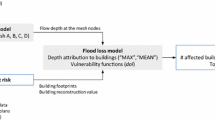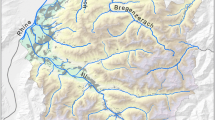Abstract
Applied flood risk analyses, especially in urban areas, very often pose the question how detailed the analysis needs to be in order to give a realistic figure of the expected risk. The methods used in research and practical applications range from very basic approaches with numerous simplifying assumptions up to very sophisticated, data and calculation time demanding applications both on the hazard and on the vulnerability part of the risk. In order to shed some light on the question of required model complexity in flood risk analyses and outputs sufficiently fulfilling the task at hand, a number of combinations of models of different complexity both on the hazard and on the vulnerability side were tested in a case study. The different models can be organized in a model matrix of different complexity levels: On the hazard side, the approaches/models selected were (A) linear interpolation of gauge water levels and intersection with a digital elevation model (DEM), (B) a mixed 1D/2D hydraulic model with simplifying assumptions (LISFLOOD-FP) and (C) a Saint-Venant 2D zero-inertia hyperbolic hydraulic model considering the built environment and infrastructure. On the vulnerability side, the models used for the estimation of direct damage to residential buildings are in order of increasing complexity: (I) meso-scale stage-damage functions applied to CORINE land cover data, (II) the rule-based meso-scale model FLEMOps+ using census data on the municipal building stock and CORINE land cover data and (III) a rule-based micro-scale model applied to a detailed building inventory. Besides the inundation depths, the latter two models consider different building types and qualities as well as the level of private precaution and contamination of the floodwater. The models were applied in a municipality in east Germany, Eilenburg. It suffered extraordinary damage during the flood of August 2002, which was well documented as were the inundation extent and depths. These data provide an almost unique data set for the validation of flood risk analyses. The analysis shows that the combination of the 1D/2D model and the meso-scale damage model FLEMOps+ performed best and provide the best compromise between data requirements, simulation effort, and an acceptable accuracy of the results. The more detailed approaches suffered from complex model set-up, high data requirements, and long computation times.








Similar content being viewed by others
References
Al-Futaisi A, Stedinger JR (1999) Hydrologic and economic uncertainties and flood-risk project design. J Water Resour Plan Manag 125(6):314–324. doi:10.1061/(ASCE)0733-9496(1999)125:6(314)
Apel H, Merz B, Thieken AH (2008) Influence of dike breaches on flood frequency estimation. Comput Geosci. doi:10.1016/j.cageo.2007.11.003
Aronica G, Lanza L (2005) Drainage efficiency in urban environment. Hydrol Process 19(5):1105–1119. doi:10.1002/hyp.5648
Aronica G, Nasello C, Tucciarelli T (1998) 2D multilevel model for flood wave propagation in flood-affected areas. J Water Resour Plan Manag 124(4):210–217. doi:10.1061/(ASCE)0733-9496(1998)124:4(210)
Baddiley P (2003) The flood risk in Cairns. Nat Hazards 30(2):155–164. doi:10.1023/A:1026114316844
Bates PD, De Roo APJ (2000) A simple raster-based model for flood inundation simulation. J Hydrol (Amst) 236(1–2):54–77. doi:10.1016/S0022-1694(00)00278-X
Blong R (2003) A new damage index. Nat Hazards 30(1):1–23. doi:10.1023/A:1025018822429
Buck W, Merkel U (1999) Auswertung der HOWAS – Datenbank (Analysis of the HOWAS data base), Institut für Wasserwirtschaft und Kulturtechnik (IWK) der Universität Karlsruhe, Karlsruhe, Report Nr. HY 98/15
Büchele B, Kreibich H, Kron A, Thieken A, Ihringer J, Oberle P et al (2006) Flood-risk mapping: contributions towards an enhanced assessment of extreme events and associated risks. Nat Hazards Earth Syst Sci 6:485–503
Chow VT (1973) Open-channel hydraulics. McGraw-Hill, New York, 680 pp
Chow VT, Maidment DR, Mays LW (1988) Applied hydrology. McGraw-Hill, New York, 572 pp
Downton MW, Pielke RA Jr (2005) How accurate are disaster loss data? The case of U.S. flood damage. Nat Hazards 35:211–228. doi:10.1007/s11069-004-4808-4
Dutta D, Herath S, Musiake K (2003) A mathematical model for flood loss estimation. J Hydrol (Amst) 277:24–49. doi:10.1016/S0022-1694(03)00084-2
Dutta D, Herath S, Musiake K (2006) An application of a flood risk analysis system for impact analysis of a flood control plan in a river basin. Hydrol Process 20(6):1365–1384. doi:10.1002/hyp.6092
Efron B (1979) Bootstrap methods: another look at the Jackknife. Ann Stat 7:1–26. doi:10.1214/aos/1176344552
EU (2007) European Flood Directive: Richtlinie 2007/60/EG des europäischen Parlaments und der Rates vom 23. Okt. 2007 über die Bewertung und das Management von Hochwasserrisiken, Amtsblatt der Europäischen Union, L 288, pp 27–34
Ganoulis J (2003) Risk-based floodplain management: a case study from Greece. Int J River Basin Manag 1:41–47
Geodaten INFAS (2001) Das Data Wherehouse. Bonn, INFAS GEOdaten GmbH, Status: Dezember 2001
Grabbert J-H (2006) Analyse der schadensbeeinflussenden Faktoren des Hochwassers 2002 und Ableitung eines mesoskaligen Abschätzungsmodells für Wohngebäudeschäden. Thesis, University of Potsdam, 109 pp (in German)
Green C (2003) Handbook of water economics: principles and practice. Wiley, Chichester
Grünthal G, Thieken AH, Schwarz J, Radtke KS, Smolka A, Merz B (2006) Comparative risk assessments for the city of Cologne—storms, floods, earthquakes. Nat Hazards 38:21–44. doi:10.1007/s11069-005-8598-0
Hall JW, Dawson RJ, Sayers PB, Rosu C, Chatterton JB, Deakin R (2003) A methodology for national-scale flood risk assessment. Water Marit Eng 156:235–247. doi:10.1680/maen.156.3.235.37976
Hardmeyer K, Spencer MA (2007) Bootstrap methods: another look at the Jackknife and geographic information systems to assess flooding problems in an urban watershed in Rhode Island. Environ Manag 39:563–574
Horritt MS, Bates PD (2001) Predicting floodplain inundation: raster-based modelling versus the finite element approach. Hydrol Process 15:825–842. doi:10.1002/hyp.188
Hunter NM, Horritt M, Bates PD, Wilson MD, Werner MGF (2005) An adaptive time step solution for raster-based storage cell modelling of floodplain inundation. Adv Water Resour 28(9):975–991. doi:10.1016/j.advwatres.2005.03.007
Hydrotec (2001) Hochwasser-Aktionsplan Angerbach. Teil I: Berichte und Anlagen. Studie im Auftrag des StUA Düsseldorf, Aachen
ICPR (2001) Atlas on the risk of flooding and potential damage due to extreme floods of the Rhine. International Commission for the Protection of the Rhine (ICPR), Koblenz, Germany
ICPR (International Commission for the Protection of the Rhine) (2002) Non structural flood plain management—measures and their effectiveness, report. Koblenz, Germany
Kelman I, Spence R (2004) An overview of flood actions on buildings. Eng Geol 73:297–309. doi:10.1016/j.enggeo.2004.01.010
Kleist L, Thieken AH, Köhler P, Müller M, Seifert I, Borst D et al (2006) Estimation of the regional stock of residential buildings as a basis for comparative risk assessment for Germany. Nat Hazards Earth Syst Sci 6:541–552
Kreibich H, Thieken AH, Petrow T, Muller M, Merz B (2005) Flood loss reduction of private households due to building precautionary measures—lessons learned from the Elbe flood in August 2002. Nat Hazards Earth Syst Sci 5(1):117–126
Krzysztofowicz R, Davis DR (1983) Category-unit loss functions for flood forecast-response system evaluation. Water Resour Res 19(6):1476–1480. doi:10.1029/WR019i006p01476
Mennis J (2003) Generating surface models of population using dasymetric mapping. Prof Geogr 55(1):31–42
Merz B, Thieken AH (2004) Flood risk analysis: concepts and challenges. Österreichische Wasser und Abfallwirtschaft 56(3–4):27–34
Merz B, Kreibich H, Thieken A, Schmidtke R (2004) Estimation uncertainty of direct monetary flood damage to buildings. Nat Hazards Earth Syst Sci 4(1):153–163
Messner F, Meyer V (2005) Flood damage, vulnerability and risk perception—challenges for flood damage research. UFZ discussion paper 13/2005
Mileti DS (1999) Disasters by design: a reassessment of natural hazards in the United States. Joseph Henry, Washington, DC
MURL (2000) Potentielle Hochwasserschäden am Rhein in NRW - Ministerium für Umwelt. Raumordnung und Landwirtschaft des Landes Nordrhein-Westfalen, Düsseldorf
NRC (National Research Council) (2000) Risk analysis and uncertainty in flood damage reduction studies. National Academy Press, Washington, DC
Olschweski A (2007) Abschätzung von Hochwasserschäden in Privathaushalten—ein Modellvergleich. Diploma thesis, Humboldt-University Berlin, 109 pp
Olsen JR, Beling PA, Lambert JH, Haimes YY (1998) Inputoutput economic evaluation of system of levees. J Water Resour Plan Manag 124(5):237–245. doi:10.1061/(ASCE)0733-9496(1998)124:5(237)
Penning-Rowsell EC, Green C (2000) New insights into the appraisal of flood-alleviation benefits: (1) Flood damage and flood loss information. J Chart Inst Water Environ Manag 14:347–353. doi:10.1111/j.1747-6593.2000.tb00272.x
Penning-Rowsell E, Johnson C, Tunstall S, Tapsell S, Morris J, Chatterton J et al (2005) The benefits of flood and coastal risk management: a manual of assessment techniques. Middlesex University Press, UK
Resendiz-Carrillo D, Lave LB (1990) Evaluating dam safety retrofits with uncertain benefits: the case of Mohawk Dam. Water Resour Res 26(5):1093–1098
Rodda HJE (2005) The development and application of a flood risk model for the Czech Republic. Nat Hazards 36:207–220. doi:10.1007/s11069-004-4549-4
Scawthorn C, Flores P, Blais N, Seligson H, Tate E, Chang S et al (2006) HAZUS-MH flood loss estimation methodology II. Damage and loss assessment. Nat Hazards Rev 7:72–81. doi:10.1061/(ASCE)1527-6988(2006)7:2(72)
Schmidt-Thomé P, Greiving S, Kallio H, Fleischhauer H, Jarva J (2006) Economic risk maps of floods and earthquakes for European regions. Quat Int 150:103–112. doi:10.1016/j.quaint.2006.01.024
Schwarz J, Maiwald H, Gerstberger A (2005) Quantifizierung der Schäden infolge Hochwassereinwirkung: Fallstudie Eilenburg. Bautechnik 82(12):845–856. doi:10.1002/bate.200590247
SMI (Saxonian Ministry of the Interior) (2002) Verwaltungsvorschrift des Sächsischen Staatsministeriums des Innern zur Behebung von Hochwasserschäden an Wohngebäuden, p 8 (in German)
Smith DI (1981) Actual and potential flood damage: a case study for urban Lismore, NSW, Australia. Appl Geogr 1:31–39. doi:10.1016/0143-6228(81)90004-7
Smith DI (1994) Flood damage estimation–a review of urban stage-damage curves and loss functions. Water SA 20(3):231–238
Stedinger JR, Vogel RM, Foufoula-Georgiou E (1993) Frequency analysis of extreme events. In: Maidment DR (ed) Handbook of Hydrology. McGraw-Hill, New York, pp 18.1–18.66
Takeuchi K (2001) Increasing vulnerability to extreme floods and societal needs of hydrological forecasting. Hydrol Sci J 46(6):869–881
Thieken AH, Müller M, Kreibich H, Merz B (2005) Flood damage and influencing factors: new insights from the August 2002 flood in Germany. Water Resour Res 41(12):W12430. doi:10.1029/2005WR004177
Thieken AH, Kreibich H, Merz B (2006) Improved modelling of flood losses in private households. In: Kundzewicz Z, Hattermann F (eds) Natural systems and global change. Polish Academy of Sciences and Potsdam Institute of Climate Impact Research, Poznan, pp 142–150
USACE (U.S Army Corps of Engineers) (1996) Risk-based analysis for flood damage reduction studies. Engineering Manual 1110-2-1619, Washington, DC
Wind HG, Nierop TM, de Blois CJ, de Kok JL (1999) Analysis of flood damages from the 1993 and 1995 Meuse flood. Water Resour Res 35(11):3459–3465. doi:10.1029/1999WR900192
Author information
Authors and Affiliations
Corresponding author
Rights and permissions
About this article
Cite this article
Apel, H., Aronica, G.T., Kreibich, H. et al. Flood risk analyses—how detailed do we need to be?. Nat Hazards 49, 79–98 (2009). https://doi.org/10.1007/s11069-008-9277-8
Received:
Accepted:
Published:
Issue Date:
DOI: https://doi.org/10.1007/s11069-008-9277-8




